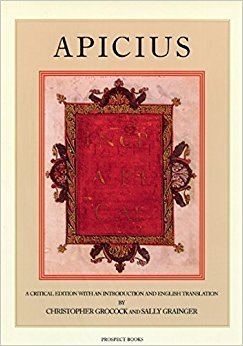Originally published 1483 | Genre Cookbook | |
 | ||
Similar Cookbooks, Gastronomy books | ||
Apicius 19
Apicius is a collection of Roman cookery recipes, usually thought to have been compiled in the late 4th or early 5th century AD and written in a language that is in many ways closer to Vulgar than to Classical Latin; later recipes using Vulgar Latin (such as ficatum, bullire) were added to earlier recipes using Classical Latin (such as iecur, fervere).
Contents
The name "Apicius" had long been associated with excessively refined love of food, from the habits of an early bearer of the name, Marcus Gavius Apicius, a Roman gourmet and lover of refined luxury, who lived sometime in the 1st century AD during the reign of Tiberius. He is sometimes erroneously asserted to be the author of the book that is pseudepigraphically attributed to him.
Apicius is a text to be used in the kitchen. In the earliest printed editions, it was most usually given the overall title De re coquinaria (On the Subject of Cooking) and attributed to an otherwise unknown Caelius Apicius, an invention based on the fact that one of the two manuscripts is headed with the words "API CAE" or rather because there are a few recipes attributed to Apicius in the text: Patinam Apicianam sic facies (IV, 14) Ofellas Apicianas (VII, 2).
Organization
The text is organized in ten books, in an arrangement similar to that of a modern cookbook:
- Epimeles — The Careful Housekeeper
- Sarcoptes — The Meat Mincer
- Cepuros — The Gardener
- Pandecter — Many Ingredients
- Ospreon — Pulse
- Aeropetes — Birds
- Polyteles — The Gourmet
- Tetrapus — The Quadruped
- Thalassa — The Sea
- Halieus — The Fisherman
Foods
The foods described in the book are useful for reconstructing the dietary habits of the ancient world around the Mediterranean Basin. But the recipes are geared for the wealthiest classes, and a few contain what were exotic ingredients at that time (e.g., flamingo). A sample recipe from Apicius (8.6.2–3) follows:
Alternative editions
In a completely different manuscript, there is also a very abbreviated epitome entitled Apici excerpta a Vinidario, a "pocket Apicius" by "an illustrious man" named Vinidarius, made as late as the Carolingian era. The Vinidarius of this book may have been a Goth, in which case his Gothic name may have been Vinithaharjis, but this is only conjecture. Despite being called "illustrious," nothing about him is truly known.
Apici excerpta a Vinidario survives in a single 8th-century uncial manuscript. Despite the title, this booklet is not an excerpt purely from the Apicius text we have today, as it contains material that is not in the longer Apicius manuscripts. Either some text was lost between the time the excerpt was made and the time the manuscripts were written, or there never was a "standard Apicius" text because the contents changed over time as it was adapted by readers.
Once manuscripts surfaced, there were two early printed editions of Apicius, in Milan (1498, under the title In re quoquinaria) and Venice (1500). Four more editions in the next four decades reflect the appeal of Apicius. In the long-standard edition of C. T. Schuch (Heidelberg, 1867), the editor added some recipes from the Vinidarius manuscript.
Between 1498 (the date of the first printed edition) and 1936 (the date of Joseph Dommers Vehling's translation into English and bibliography of Apicius), there were 14 editions of the Latin text (plus one possibly apocryphal edition). The work was not widely translated, however; the first translation was into Italian, in 1852, followed in the 20th century by two translations into German and French. The French translation by Bertrand Guégan was awarded the 1934 Prix Langlois by the Académie française.
Vehling made the first translation of the book into English under the title Cookery and Dining in Imperial Rome. It was published in 1936 and is still in print, having been reprinted in 1977 by Dover Publications. It is now of historical interest only, since Vehling's knowledge of Latin was not always adequate for the difficult task of translation, and several later and more reliable translations now exist.
